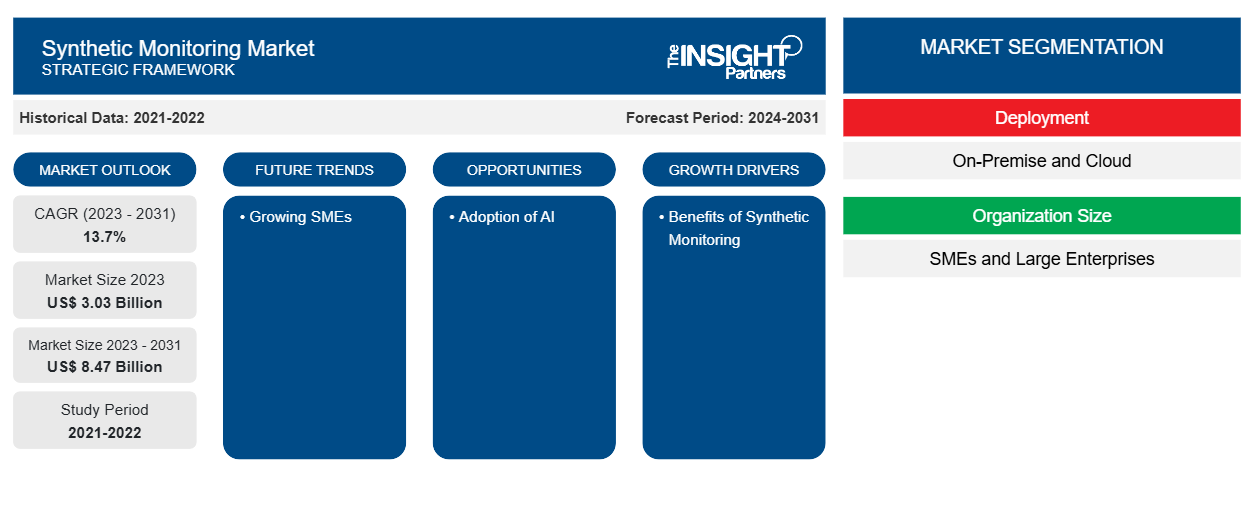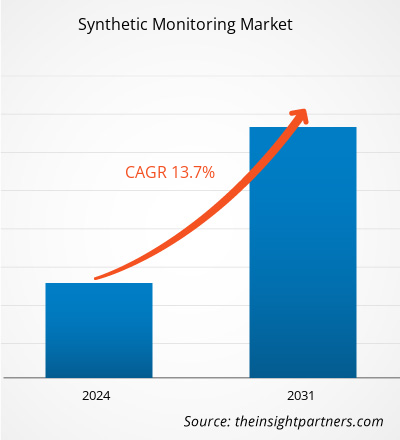The synthetic monitoring market size is projected to reach US$ 8.47 billion by 2031 from US$ 3.03 billion in 2023. The market is expected to register a CAGR of 13.7% in 2023–2031. The growing cloud adoption and rise in digitalization are likely to remain key to synthetic monitoring market trends.
Synthetic Monitoring Market Analysis
Government support to boost the SMEs' capabilities to their business by providing financial aid, incentives, and initiatives can contribute to the adoption of software solutions such as synthetic monitoring solutions. The growing cloud market is one of the major factors driving the synthetic monitoring market as the cloud is a cost-effective solution that leads to the adoption of cloud-based Synthetic monitoring solutions by several large enterprises and SMEs, which further drives the synthetic monitoring market.
Synthetic Monitoring Market Overview
Synthetic monitoring refers to the use of software to simulate user interactions with a system. The data collected from the simulated transactions is then analyzed to determine how the system operates. For example, synthetic monitoring could be used to determine whether a website achieves the desired page load, response time, and uptime.
Customize This Report To Suit Your Requirement
You will get customization on any report - free of charge - including parts of this report, or country-level analysis, Excel Data pack, as well as avail great offers and discounts for start-ups & universities
Synthetic Monitoring Market: Strategic Insights

-
Get Top Key Market Trends of this report.This FREE sample will include data analysis, ranging from market trends to estimates and forecasts.
Synthetic Monitoring Market Drivers and Opportunities
Benefits of Synthetic Monitoring to Favor Market
Synthetic monitoring solutions allow the end-user to predict how a system will respond to user requests before actual users interact with it. Synthetic monitoring allows the end-user to validate whether systems meet performance and availability requirements before going into production. In this respect, synthetic monitoring allows for proactive monitoring. Furthermore, synthetic monitoring is useful for evaluating a system's response to unusual or infrequent requests that may not be captured in data collected from transactions initiated by real users. Thus, synthetic monitoring helps to validate system performance and identify potential issues before they affect the end-user experience. Synthetic monitoring enables monitoring proactively and addresses performance and availability issues before they disrupt production applications, which helps the end-users enhance their customer experience.
Growing SMEs market
Enterprises use synthetic monitoring tools to monitor enterprise applications, and they provide information about uptime and overall performance of critical business transactions by simulating several customer activities. These tools enable businesses to close performance gaps that may impact the overall end-user experience. Thus, the growing digitalization and government support for SMEs foster SMEs' capability to adopt software solutions to enhance the efficiency of their workflow. Furthermore, as the trend of digital transformation to improve overall operational efficiency and end-user experience, more SMEs will adopt synthetic monitoring solutions in the future.
Synthetic Monitoring Market Report Segmentation Analysis
Key segments that contributed to the derivation of the synthetic monitoring market analysis are ink deployment, organization size, monitoring type, and industry.
- By deployment, the market is segmented into on-premise and cloud. The cloud segment is expected to grow with the highest CAGR.
- Based on the organization size, the market is segmented into SMEs and large enterprises. The SMEs segment is expected to grow with the highest CAGR.
- By monitoring type, the market is segmented into API monitoring, SaaS application monitoring, mobile application monitoring, and web application monitoring. The API monitoring segment held the largest market share in 2023.
- Based on the industry, the market is segmented into BFSI, government, retail, healthcare, it & telecom, and other industries. The retail segment is expected to grow with the highest CAGR.
Synthetic Monitoring Market Share Analysis by Geography
The geographic scope of the synthetic monitoring market report is mainly divided into five regions: North America, Asia Pacific, Europe, Middle East & Africa, and South America/South & Central America.
Asia Pacific region is expected to grow with the highest CAGR. The proliferation of cloud technology in the region leads to the region’s market growth. The growing SMEs in the region fuel the demand for software solutions in the region, driving the use of synthetic monitoring technology. Digital transformation in emerging economies such as India and China leads to the adoption of synthetic monitoring solutions in various end-user industries.
Synthetic Monitoring Market Regional InsightsThe regional trends and factors influencing the Synthetic Monitoring Market throughout the forecast period have been thoroughly explained by the analysts at The Insight Partners. This section also discusses Synthetic Monitoring Market segments and geography across North America, Europe, Asia Pacific, Middle East and Africa, and South and Central America.
Synthetic Monitoring Market Report Scope
| Report Attribute | Details |
|---|---|
| Market size in 2023 | US$ 3.03 Billion |
| Market Size by 2031 | US$ 8.47 Billion |
| Global CAGR (2023 - 2031) | 13.7% |
| Historical Data | 2021-2022 |
| Forecast period | 2024-2031 |
| Segments Covered |
By Deployment
|
| Regions and Countries Covered |
North America
|
| Market leaders and key company profiles |
|
Synthetic Monitoring Market Players Density: Understanding Its Impact on Business Dynamics
The Synthetic Monitoring Market is growing rapidly, driven by increasing end-user demand due to factors such as evolving consumer preferences, technological advancements, and greater awareness of the product's benefits. As demand rises, businesses are expanding their offerings, innovating to meet consumer needs, and capitalizing on emerging trends, which further fuels market growth.

- Get the Synthetic Monitoring Market top key players overview
Synthetic Monitoring Market News and Recent Developments
The Synthetic Monitoring Market is evaluated by gathering qualitative and quantitative data post primary and secondary research, which includes important corporate publications, association data, and databases. The following is a list of developments in the market:
- In July 2023, Google introduced synthetic monitoring, a new proactive monitoring capability that uses automated Node.js scripts to simulate user interactions with an application or service. This allows you to test the availability, consistency, and performance of your web applications, APIs, and key business workflows from the perspective of a real user on a periodic basis. In November 2023, Google announced the general availability of synthetic monitoring. Additionally, with this launch, the company also included new capabilities for synthetic monitoring. (Source: Google, Press Release, 2023)
- In March 2022, Synthetic API Monitoring extended AppDynamics Synthetic Monitoring, empowering ITOps and DevOps to help minimize the impact of API performance and availability issues on business outcomes and user experience. (Source: AppDynamics, Press Release, 2022)
Synthetic Monitoring Market Report Coverage and Deliverables
The “Synthetic Monitoring Market Size and Forecast (2021–2031)” report provides a detailed analysis of the market covering below areas:
- Market size and forecast at global, regional, and country levels for all the key market segments covered under the scope
- Market dynamics such as drivers, restraints, and key opportunities
- Key future trends
- Detailed PEST/Porter’s Five Forces and SWOT analysis
- Global and regional market analysis covering key market trends, major players, regulations, and recent market developments
- Industry landscape and competition analysis covering market concentration, heat map analysis, prominent players, and recent developments
- Detailed company profiles
Frequently Asked Questions
What is the estimated market size for the global synthetic monitoring market in 2023?
What are the driving factors impacting the global synthetic monitoring market?
What are the future trends of the global synthetic monitoring market?
Which are the key players holding the major market share of the global synthetic monitoring market?
What will be the market size of the global synthetic monitoring market by 2031?
What is the incremental growth of the global synthetic monitoring market during the forecast period?
- Historical Analysis (2 Years), Base Year, Forecast (7 Years) with CAGR
- PEST and SWOT Analysis
- Market Size Value / Volume - Global, Regional, Country
- Industry and Competitive Landscape
- Excel Dataset
Recent Reports
Testimonials
Reason to Buy
- Informed Decision-Making
- Understanding Market Dynamics
- Competitive Analysis
- Identifying Emerging Markets
- Customer Insights
- Market Forecasts
- Risk Mitigation
- Boosting Operational Efficiency
- Strategic Planning
- Investment Justification
- Tracking Industry Innovations
- Aligning with Regulatory Trends





















 Get Free Sample For
Get Free Sample For